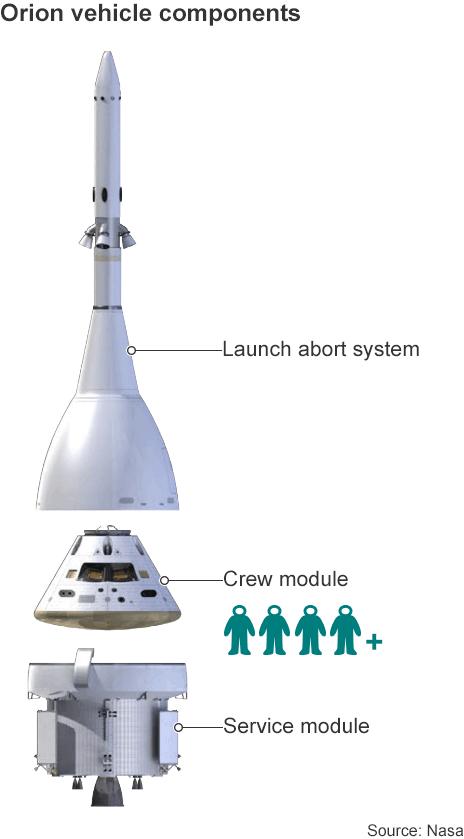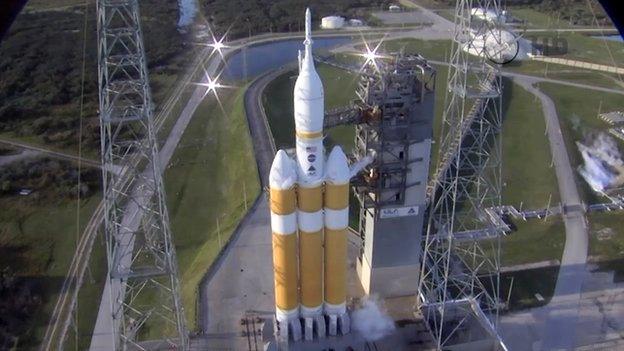Nasa’s Orion deep space capsule launches
- Published
A rocket has launched from Florida carrying an unmanned version of the US space agency's new crew capsule - Orion.
The ship is designed eventually to take humans beyond the space station, to destinations such as the Moon and Mars.
Orion's brief flight today will be used to test critical technologies, like its heat shield and parachutes.
The Delta IV-Heavy rocket roared off the pad at Cape Canaveral at 07:05 local time (12:05 GMT).
It will throw the conical ship to 6,000km above the planet, to set up a fast re-entry into the Earth's atmosphere.
This will generate temperatures in the region of 2,000C, allowing engineers to check that Orion's thermal protection systems meet their specifications.
The mission teams will also get to watch how the parachutes deploy as they gently lower the capsule into Pacific waters off the coast of Mexico's Baja Peninsula.
That splashdown is expected to occur at about 11:30 EST (16:30 GMT).
Nasa has a drone in the area hoping to relay video of the final moments of descent.

A view from one of the cameras as Orion's service module fairing separated
US Navy divers in speedboats will move in to capture Orion when it hits the water. The floating ship will then be towed into the well deck of a support vessel.
Orion is reminiscent of the Apollo command ships that took men to the Moon in the 60s and 70s, only bigger and with cutting-edge systems.
It is being developed alongside a powerful new rocket that will have its own debut in 2017 or 2018.
Together, they will form the core capabilities needed to send humans beyond the International Space Station.
The Delta IV-Heavy rocket roared off the pad at Cape Canaveral
Thursday's mission is but one small step in a very long development programme.
Unable to call upon the financial resources of the Apollo era, Nasa is instead having to take a patient path.
Even if today it had a fully functioning Orion, with its dedicated rocket, the US space agency would not be able to mount a mission to another planetary body because the technologies to carry out surface operations have not been produced yet, and it could be the 2030s before we see them all - certainly, to do a Mars mission.

To go to the Red Planet would require transfer vehicles, habitation modules, and effective supply and communication chains. And fundamental to the outcome of the whole venture would be a descent/ascent solution that enabled people to get down safely to the surface and then get back up again to make the journey home.
Nasa's chief scientist Ellen Stofan told the BBC: "We have all these technologies mapped out and we're asking, 'what is the most sustainable path we can get on (to achieve them)?' And when I say 'we', I don't just mean the United States because it's not just Nasa that's thinking about this; it's all the space agencies around the world."
To that end, the Europe Space Agency has been asked to provide the "back end" for all future Orion capsules.
This service module is principally the propulsion unit that drives Orion through space.

Nasa says it is open to similar contributions from other partners as well.
Nonetheless, some commentators, like the respected historian John Logsdon, are worried that the policy as laid out cannot continue in its current guise.
"The first Orion launch with a crew aboard is 2020/21, and then nothing very firmly is defined after that, although of course Nasa has plans. That's too slow-paced to keep the launch teams sharp, to keep everyone engaged. It's driven by the lack of money, not the technical barriers," he said.
But there is no doubting the enthusiasm within Nasa for the Orion project.
Rex Waldheim flew on the very last shuttle mission in 2011, and is now assisting the design of the capsule's interior systems.
He told BBC News: "The people that are actually going to fly in Orion - I just can't imagine the thrill they're going to have when they sit here at the Kennedy Space Centre atop the rocket, ready to go to the Moon or to Mars or an asteroid - these incredible destinations. It's just going to be spectacular."
- Published4 December 2014

- Published18 November 2014

- Published16 September 2014
